Cracking the Code of the Perfect Musical Song: A Scientific Approach to Stage Hits Published on 25 March 2025 by London Theatre Direct
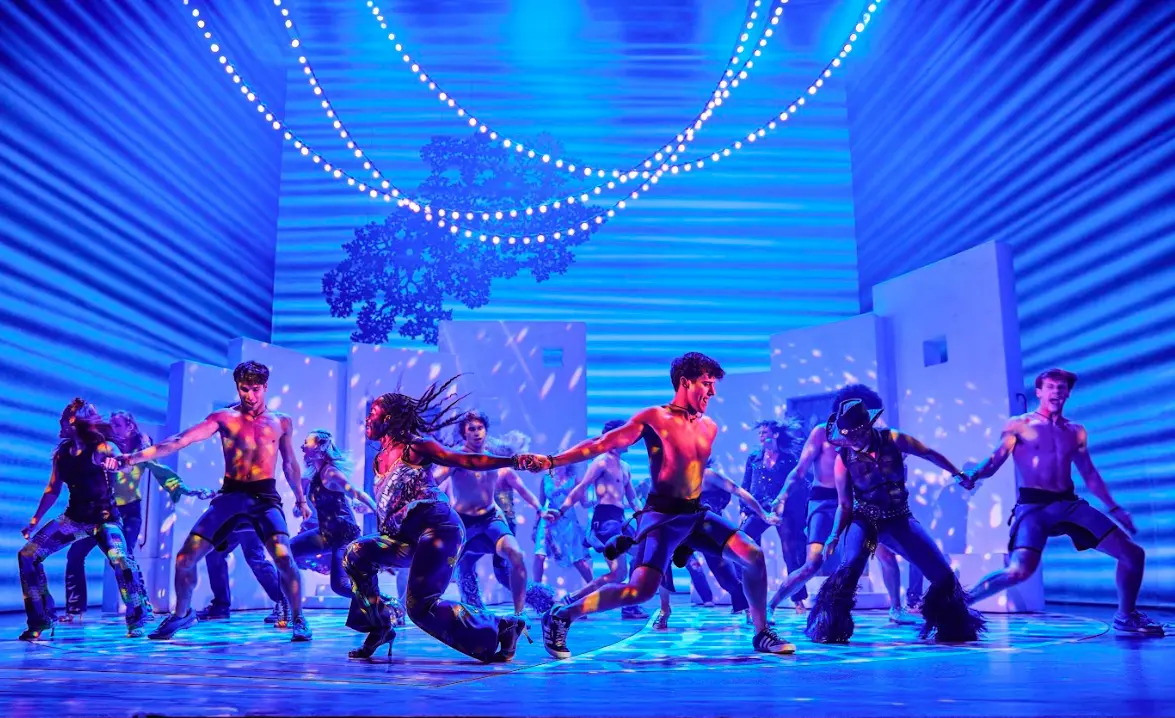
Thanks in no small part to Wicked selling out movie theatres and coming close to setting cinematic box office records, 2024 was a great year for musicals in the West End and beyond. With key stage productions such as The Devil Wears Prada, Hadestown, Mean Girls, and MJ The Musical, the last year has seen a host of new productions hit the stage, which combined with returning audiences and the continued success of long-running shows, helped to prove that musical theatre isn’t just alive and well, it’s thriving.
In addition to their award-winning casts, star performers, and dazzling stage props, what else makes musicals a magnet for theatregoers? By definition, music and lyrics are an integral part of the narrative of a musical and are often used to express characters’ emotions, advance the plot, or provide entertainment.
But what makes a musical song likeable, engaging, and captivating? Is there a scientific way to discover the “magic” that makes a song resonate with audiences? And what are the types of songs that best fit a musical performance?
To try and find a definitive answer to these questions, we embarked on a comprehensive data-led analysis of more than 2,000 musical hits to try and uncover the secret sauce behind an unforgettable on-stage masterpiece.
Using scientifically backed methodology and Spotify’s extensive library of audio features, we decoded the riddle-laden attributes that define the archetypal musical banger. Armed with the blueprint of the musical song, according to science, we analysed over 2,000 hits to uncover the top 20 that make an on-stage performance unforgettable!
“At London Theatre Direct, we like to think we know a great musical number when we hear one—but is there a pattern behind what makes a song a hit?
Our research explores the key traits shared by the biggest musical songs, revealing trends that keep audiences coming back. Is there a formula or just a fascinating coincidence? Take your seats and find out.”
Ryan Woods, Commercial Director, London Theatre Direct
Data Collection: A Master Playlist for the Stage
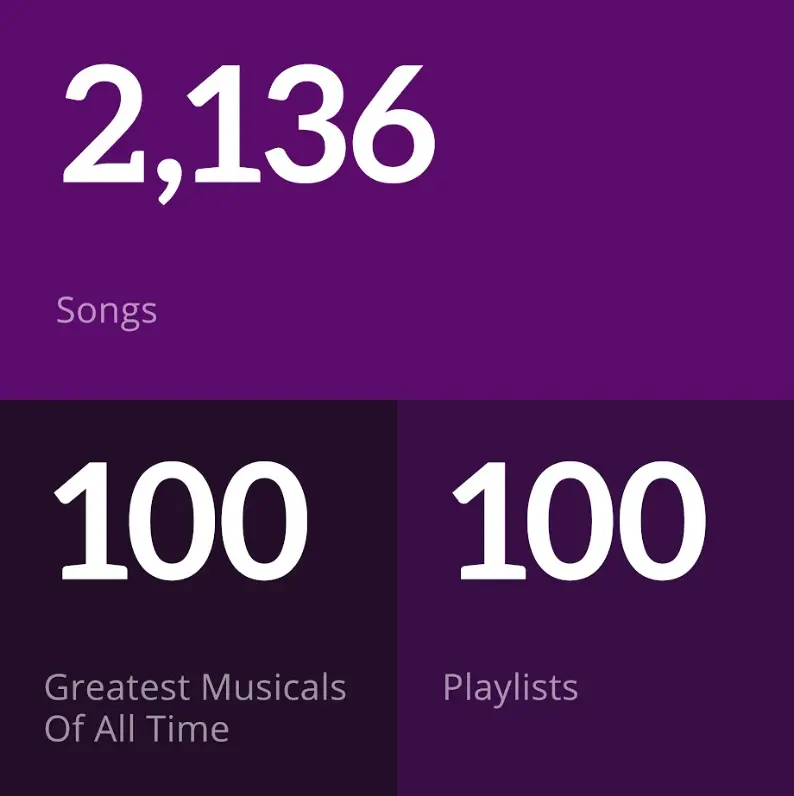
Before diving into the different elements that make a musical tune an on-stage hit, we compiled a master playlist featuring 2,136 songs from 100 of the greatest musicals of all time - from iconic audience favourites like Les Misérables and Hamilton to contemporary favourites such as Six and Moulin Rouge! The Musical.
Where available, original cast recordings were prioritised in order to ensure the purest representation of each musical’s essence. For recasts, adaptations, and touring productions, selections reflected the most faithful renditions.
Song Analysis: Key Metrics of Musical Brilliance
Before we could get to the bottom of what makes a musical song a stage hit, we selected 10 key audio features (out of Spotify’s 13) provided by the platform and used these to chart all the songs on our list.
|
Danceability |
Danceability describes how suitable a track is for dancing based on a combination of musical elements including tempo, rhythm stability, beat strength, and overall regularity. |
Danceability reflects how well a song supports on-stage movement, as highly danceable songs are often used for energetic group numbers or scenes with elaborate choreography.
It features steady rhythms and patterns that performers can synchronise with. A lower danceability score might indicate a focus on emotional storytelling or slower pacing, with minimal movement while a higher score suggests the opposite, that is a high-energy and incredibly physical performance.
|
Valence |
The musical positiveness conveyed by a track. Tracks with high valence sound more positive (e.g. happy, cheerful, euphoric), while tracks with low valence sound more negative (e.g. sad, depressed, angry). |
High-valence songs, in musicals, often appear during celebratory or comedic moments, creating a sense of joy or relief.
Lower-valence songs, however, are, more often than not, used to explore themes of struggle, loss, or introspection, drawing the audience into deeper emotional engagement and connection with the characters and the show.
|
Energy |
Energy represents a perceptual measure of intensity and activity. Typically, energetic tracks feel fast, loud, and noisy. For example, death metal has high energy, while a Bach prelude scores low on the scale. Perceptual features contributing to this attribute include dynamic range, perceived loudness, timbre, onset rate, and general entropy. |
Energy captures the intensity and dynamics of a song, and high-energy numbers are often used for pivotal scenes, driving the narrative forward or showcasing dramatic action.
On the flip side of the musical energy coin, lower-scoring songs slow the pace and allow for more reflective moments, where characters can express vulnerability or complex emotions, both of which help drive the central narrative of a production.
|
Speechiness |
Speechiness detects the presence of spoken words in a track. |
In musicals, speechiness often comes into play in numbers when dialogue transitions into song.
These changes help to maintain a conversational tone and deliver exposition or humour-laden relief while bridging the gap between spoken and sung performance.
|
Liveness |
Detects the presence of an audience in the recording. |
Liveness enhances the immersive quality of the experience, making audience members feel as though they are part of the on-stage action or the unfolding story.
|
Acousticness |
A confidence of whether the track is acoustic or not. |
Acousticness reflects how natural or organic the instrumentation is and musicals use songs with a high acousticness score to create intimacy and authenticity, often in character-driven moments, while a low acousticness score, featuring amplified or electronic elements, can heighten the drama or emphasise spectacle in larger-scale productions.
|
Tempo |
The overall estimated tempo of a track in beats per minute (BPM). In musical terminology, tempo is the speed or pace of a given piece and derives directly from the average beat duration. |
Tempo influences the scene’s mood and pacing with faster tempos driving action and excitement. Quicker tempos are often used in energetic or comedic scenes, while slower tempos provide space for introspective and tender moments, allowing characters to connect more deeply with the audience.
|
Key |
The key the track is in. Integers map to pitches using standard Pitch Class notation. |
The key determines the overall tonality of a song. Major keys are frequently used to convey optimism or resolution, while minor keys evoke tension or melancholy.
The choice of key helps shape the audience’s emotional response and can be subtly adjusted within a song to signal shifts in mood or character development.
|
Mode |
Mode indicates the modality (major or minor) of a track, the type of scale from which its melodic content is derived. |
In musicals, major modes are used to create bright, hopeful atmospheres, while minor modes bring a sense of gravity or emotional depth, and shifting between the modes within a song can reflect a character’s evolving feelings or significant turning points in the story.
|
Time Signature |
An estimated time signature. The time signature (meter) is a notational convention to specify how many beats are in each bar (or measure) |
Time signature defines the rhythmic structure of a song, shaping how beats are grouped and work together to create a response from the audience. Common time signatures are used to maintain a steady and familiar rhythm, ideal for dance or ensemble performances and more complex or unusual time signatures add variety and can mirror the uniqueness of a scene, character, or cultural influence.
“Our research suggests there may be a formula to what makes a musical song work. We found key traits that successful songs share, but there’s no single blueprint for a hit.
The best musicals use structure to their advantage while delivering something unique that keeps audiences coming back.”
Ryan Woods, Commercial Director, London Theatre Direct
Creating the Archetype: The Common Denominator of all Musical Songs
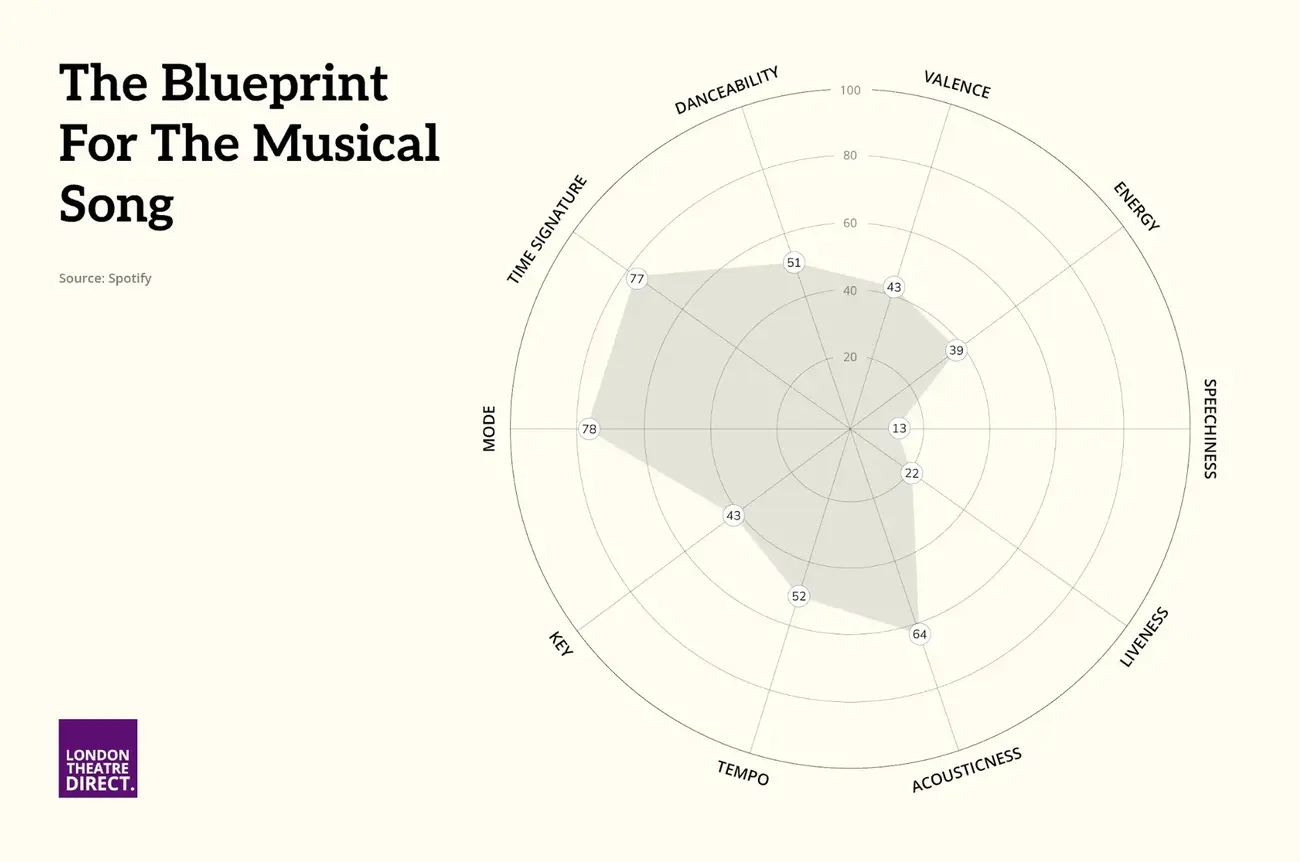
To define the blueprint for the musical song with its most common traits, we calculated the average values of all ten features in the aforementioned 2,136 songs that were collated from the top 100 musicals of all time.
Medians for each feature were used to establish the averages for the musical hit. Radar charts mapping the scores were then generated to visually represent how each song compared to this archetype.
The Commonalities of all Musical Songs
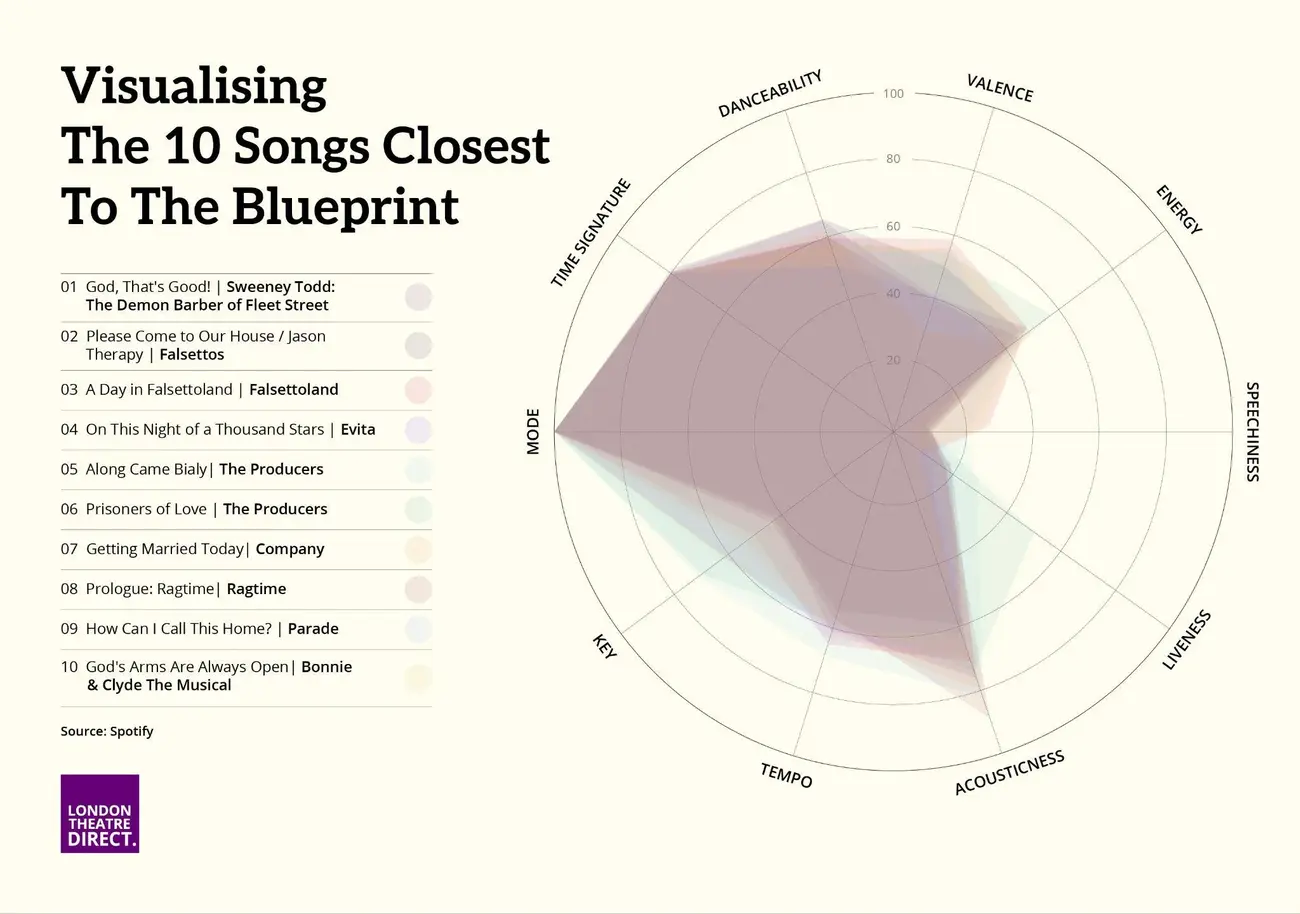
Using the model of the archetypical musical song, we analysed all 2,000+ tunes of the 100 most popular musicals and ranked them based on how close they came to median values. Here are the 10 musical songs that are closest to the archetype, meaning they hit all average values:
The average musical song, which serves as a baseline, has a danceability of 51, valence of 43, energy of 39, speechiness of 13, liveness of 22, acousticness of 64, tempo of 52 BPM, key of 43, mode of 78, and time signature of 77.
The average song is intentionally balanced to serve its narrative purpose. It avoids extremes in energy, tempo, or emotional tone, ensuring it complements the on-stage action and supports storytelling. These songs prioritise:
- Emotional depth and nuance (valence and energy)
- Natural, intimate instrumentation (acousticness)
- A balance between rhythm and expressiveness (danceability and tempo)
This archetype creates a foundation for songs that work well within the context of a musical, where the story, characters, and ensemble moments take precedence over flashy or standalone performances. From this baseline, composers can amplify specific elements (e.g., energy, danceability, or tempo) to craft standout moments, such as showstopping solos, emotional ballads, or high-energy finales.
Beyond the Archetype: What Makes a Musical Song a Streaming Phenomenon?
While the archetype for the musical song provides us with numerical median values that most songs come close to, they don’t shed light on the factors—scientific or otherwise—that make an on-stage tune a timeless hit. Some songs go beyond the balanced blueprint of the “average” musical track to become unforgettable anthems that resonate far beyond the theatre.
“Streaming success often depends on a song’s crossover appeal,” says Ryan Woods. “Tracks with strong emotional hooks or contemporary influences tend to gain traction beyond the stage and become mainstream hits.”
To uncover which musical songs truly stick with listeners, we turned to streaming data to identify the favourites that fans can’t stop hitting replay on.
According to data from Spotify and Spot on Track, and their global fanbase of musical devotees, the top twenty musical songs of all time are… 🥁:
Drumroll fades, spotlight on the stars.
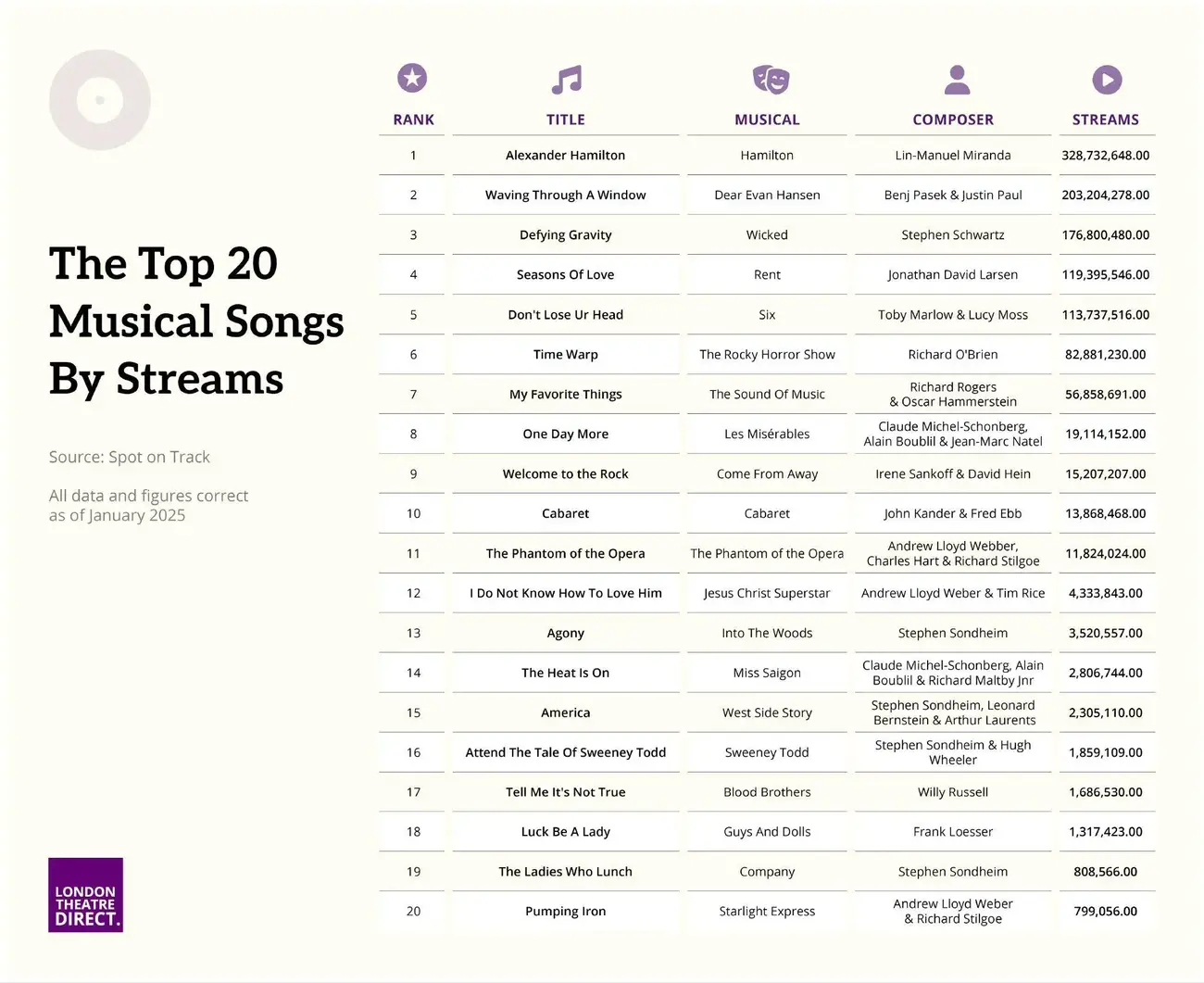
These widely popular songs don’t necessarily stick to the median; instead, they stand out by amplifying specific traits that resonate deeply with audiences. Let’s take a closer look at the top 10 most-streamed musical songs and uncover what makes them so compelling.
1. ‘Alexander Hamilton’ - Hamilton

What makes it special:
As the opening number of Hamilton,
“Alexander Hamilton” is a masterclass in storytelling, fusing Lin-Manuel Miranda’s
distinctive hip-hop style with musical theatre. Its high danceability
(63) and speechiness (30) set it apart, reflecting the
rapid-fire rap delivery that captivates audiences and brings history to life in a bold,
modern way. The moderate valence (56) and energy (44)
keep the song grounded, allowing the story to shine without being overshadowed by
theatrics. By fusing rap, rhythm, and narrative, this track challenges the archetypical
balance and sets a new standard for contemporary musicals.
2. ‘Waving Through A Window’ - Dear Evan Hansen
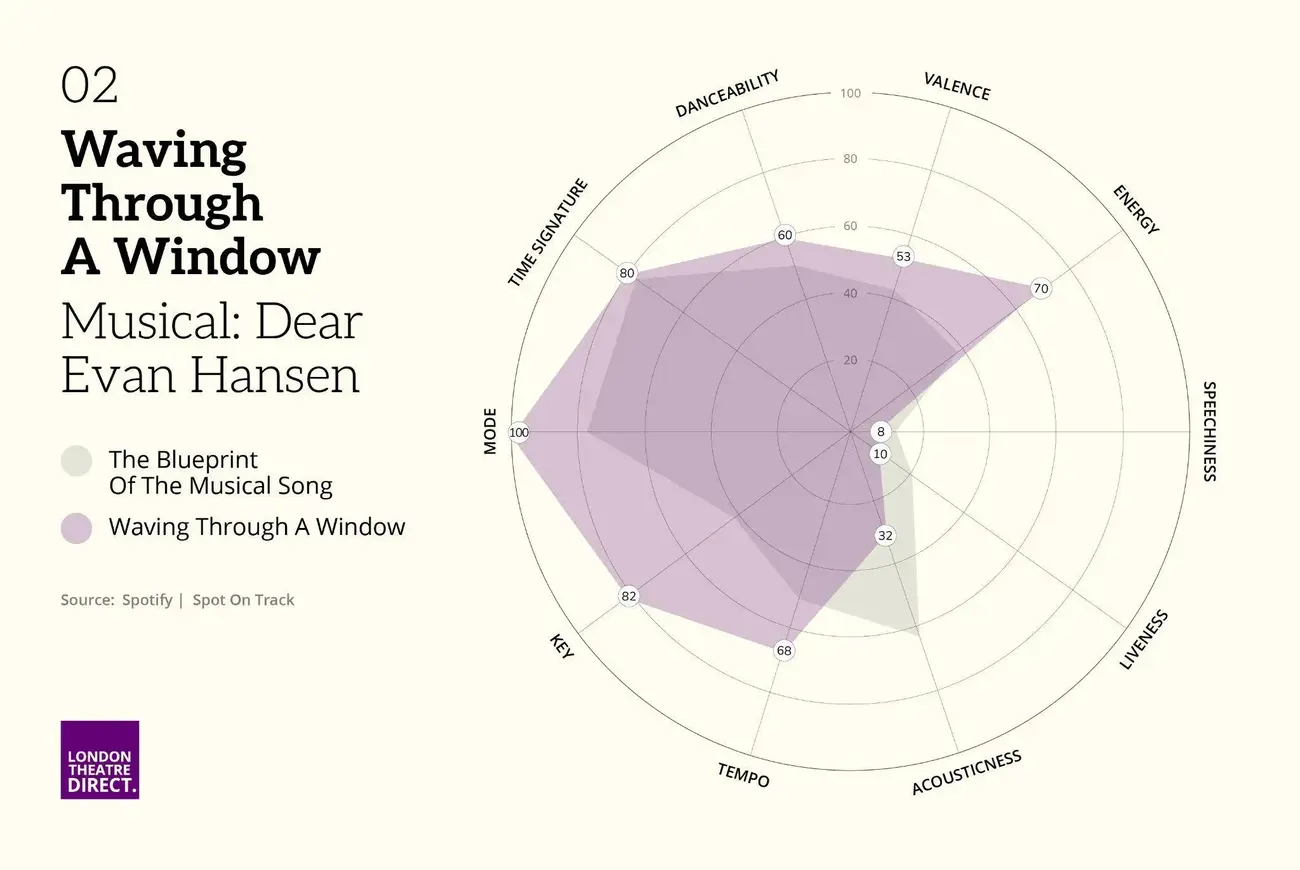
What makes it special:
This anthem of anxiety and isolation struck
a chord with audiences worldwide. Its high energy (70) and
accessible tempo (68 BPM) drive the song’s emotional intensity, while
the lower speechiness (8) ensures the melody is front and centre,
making it ideal for repeated listening. The moderate acousticness (32)
adds a contemporary pop sensibility, which appeals to younger listeners and sets it
apart from traditional theatre songs. "Waving Through a Window” is a modern, heartfelt
ballad that blends vulnerability and musical accessibility, making it a streaming
success.
3. ‘Defying Gravity’ - Wicked
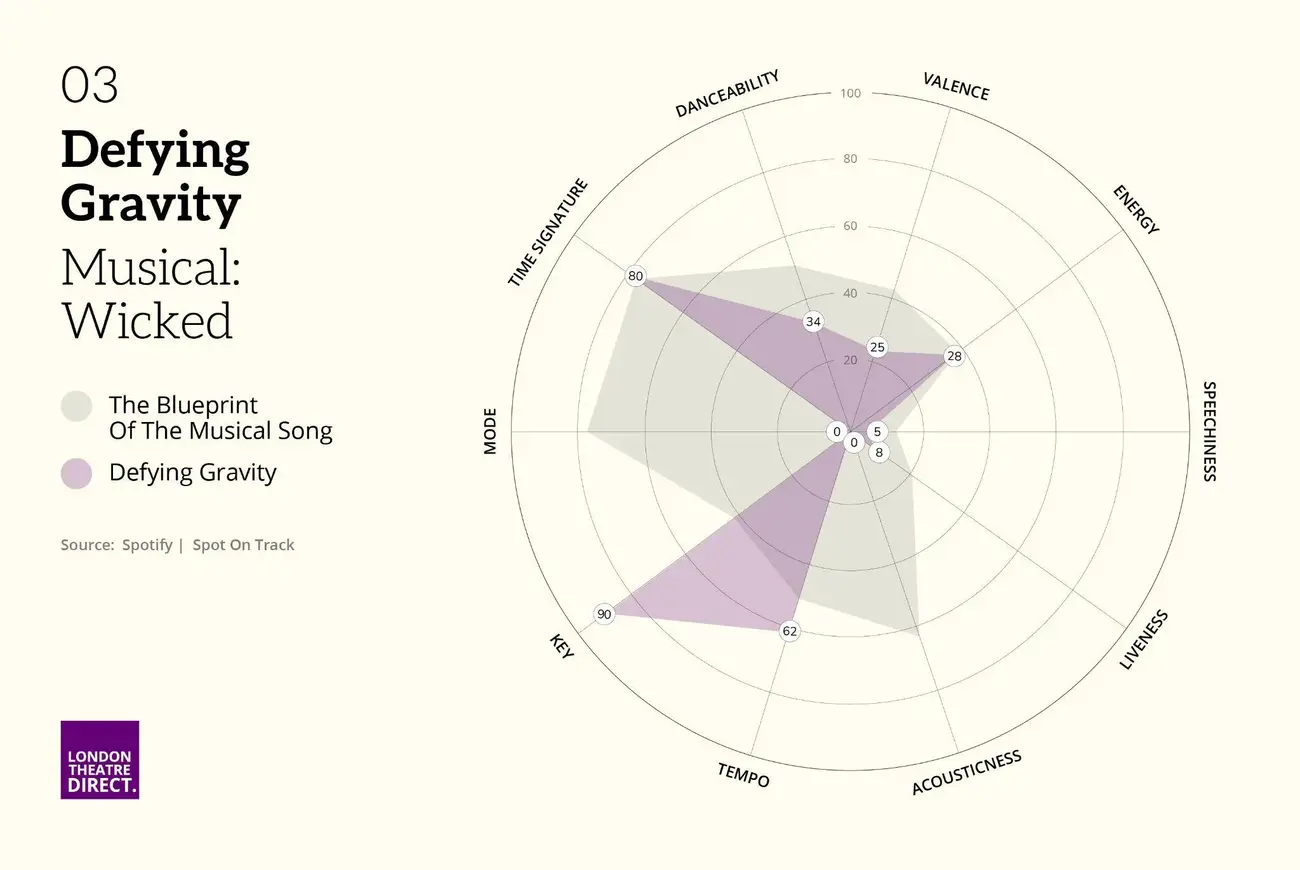
What makes it special:
This iconic number captures Elphaba’s
defining moment of empowerment. With its low danceability (34) and
valence (25), “Defying Gravity” prioritises emotional storytelling over
rhythm or positivity. The dramatic acousticness score of 0 reflects the
fully amplified orchestration, adding power to the performance. Its soaring melody and
high-stakes lyrics resonate deeply with audiences, while the medium energy
(38) allows the song’s climactic build to take centre stage. It’s not just
a song—it’s a declaration, a showstopper that leaves an indelible mark.
4. ‘Seasons of Love’ - Rent
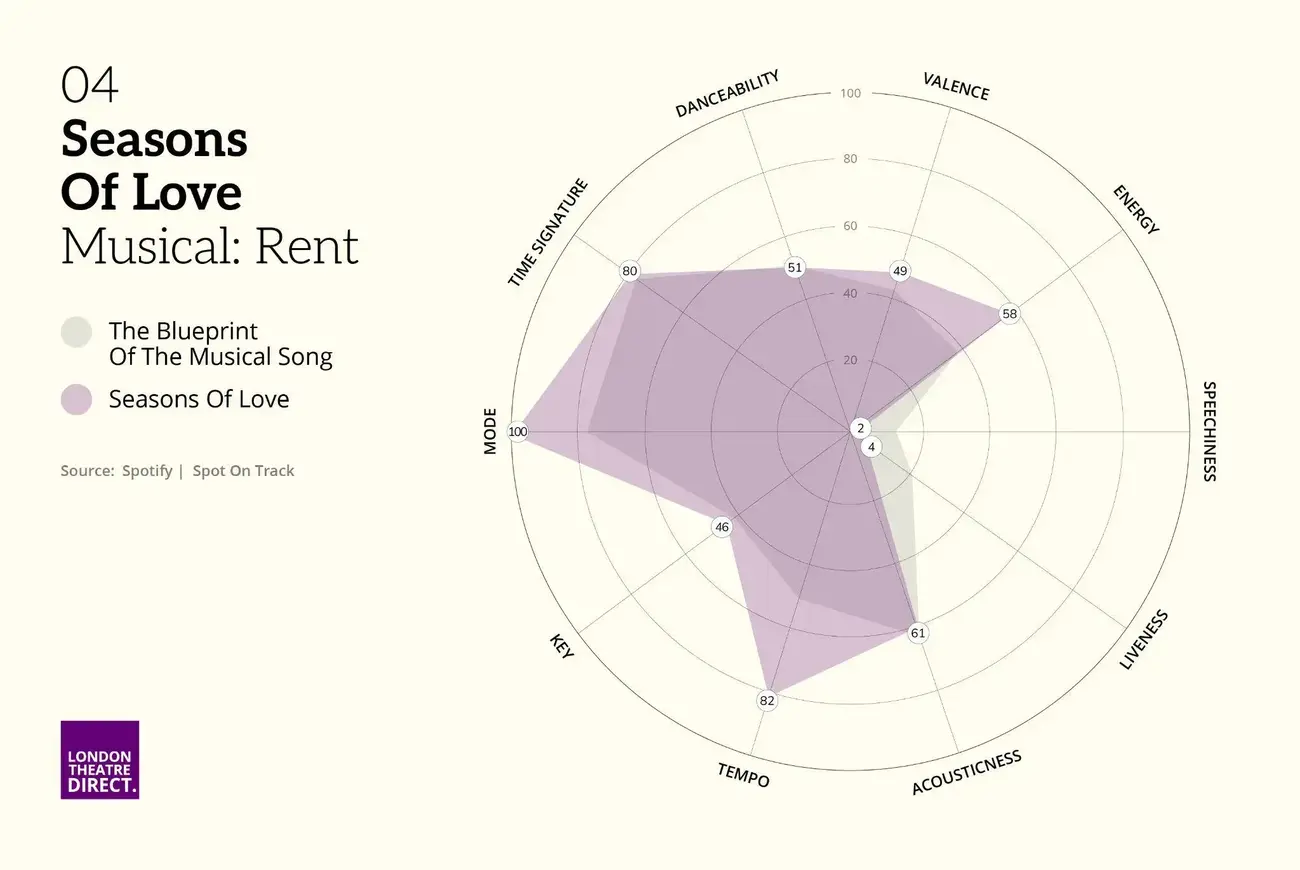
What makes it special:
"Seasons of Love" is the quintessential
feel-good anthem, thanks to its balance of danceability (51) and
valence (49), which create a warm, uplifting tone. Its moderate
acousticness (61) adds a sense of intimacy, while the steady tempo
(82 BPM) ensures singability. The universal theme of measuring life through
love makes it emotionally resonant for a wide audience, while its simplicity and
accessibility give it a timeless quality that ensures its place among the most-streamed
tracks.
5. ‘Don’t Lose Ur Head’ - Six
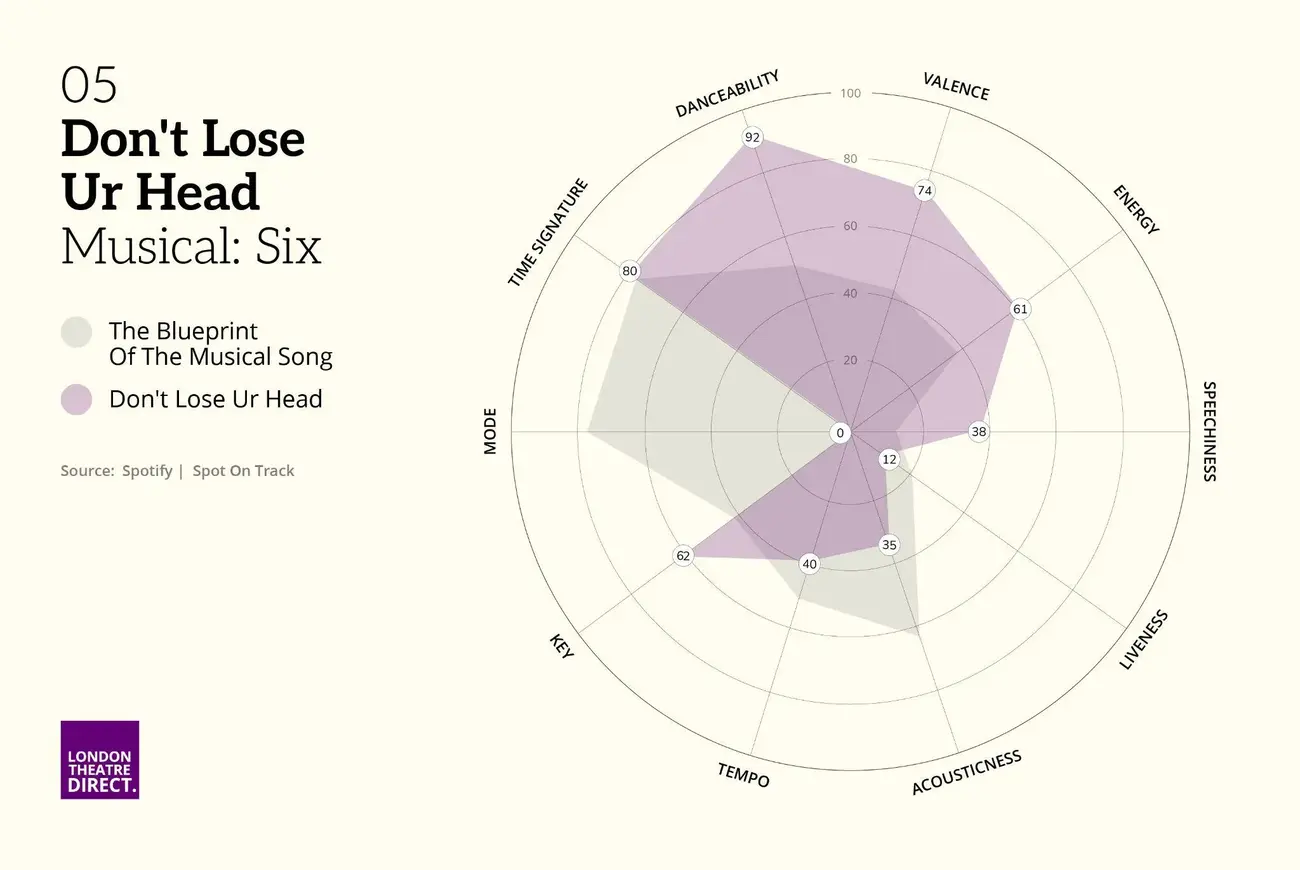
What makes it special:
This cheeky, rebellious track from
Six is a standout due to its extremely high danceability (92)
and valence (74), which create a fun, infectious energy. The
elevated speechiness (38) reflects the conversational and witty lyrics,
which modernise the story of Anne Boleyn. The pop-inspired style, with low
acousticness (35) and mid-energy (61), gives it a fresh,
radio-ready feel that appeals to streaming audiences. It’s a playful, irreverent anthem
that perfectly marries historical storytelling with contemporary music trends.
6. ‘Time Warp’ - The Rocky Horror Show
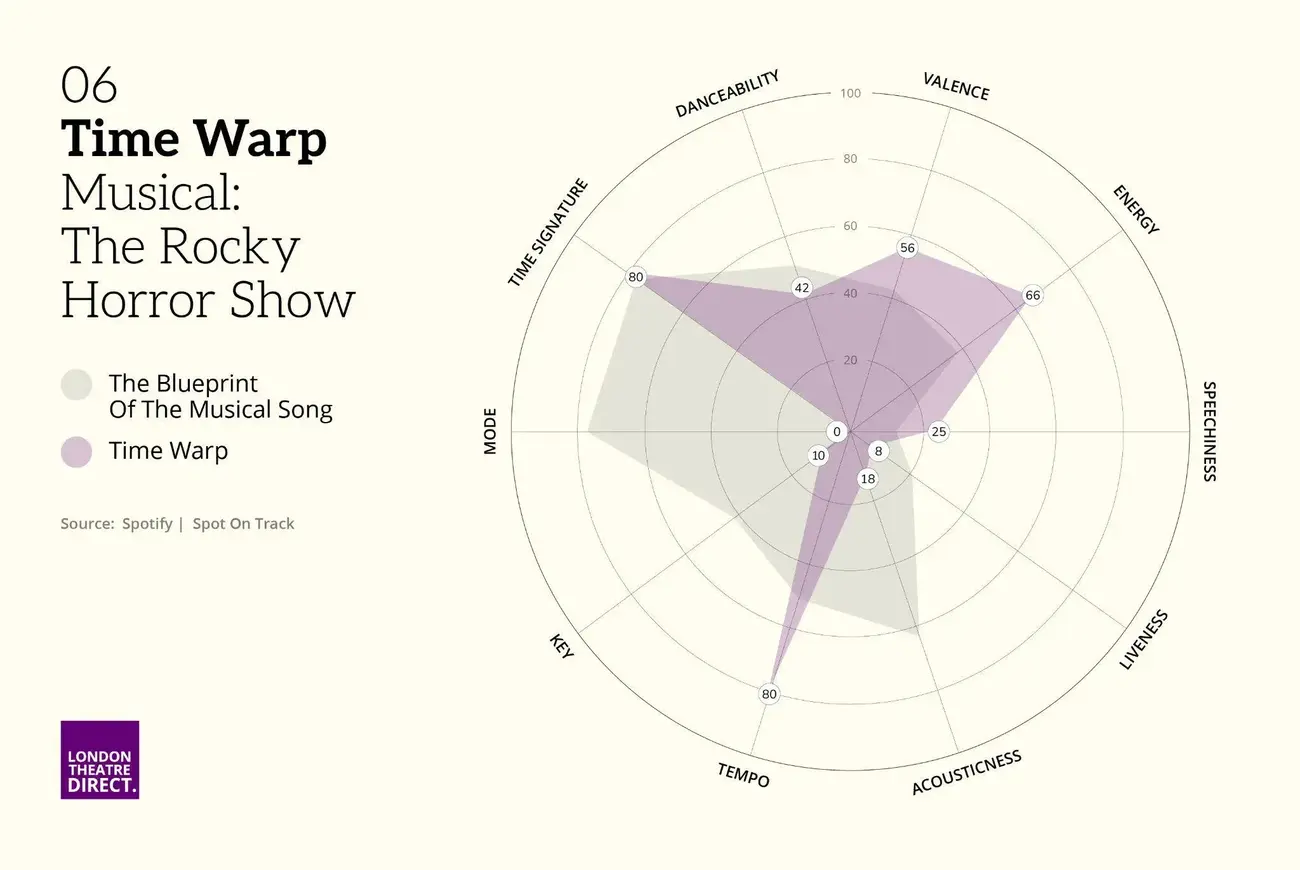
What makes it special:
As a cult classic, "Time Warp" thrives on
its high energy (66) and audience participation appeal. The
moderate valence (56) and catchy tempo (80 BPM) make
it irresistibly fun, while the low acousticness (14) and amplified
production emphasise its rock roots. Its quirky nature and interactive choreography
ensure its enduring popularity, proving that musical theatre can be as much about fun as
it is about storytelling.
7. ‘My Favorite Things’ - The Sound Of Music
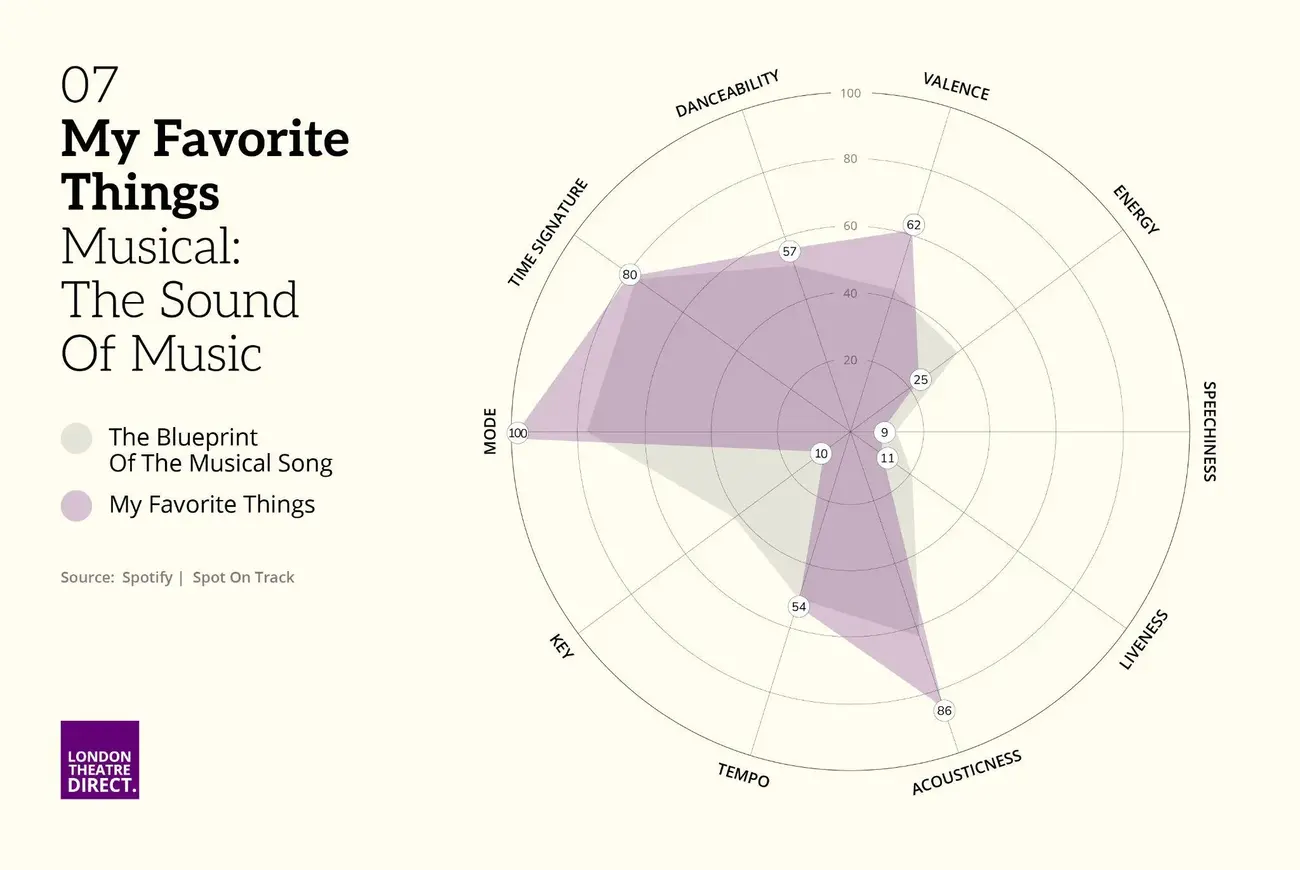
What makes it special:
This nostalgic classic captures the
comforting essence of The Sound of Music. With high acousticness
(86) and moderate valence (62), the song creates an
intimate and warm feeling, evoking childhood memories. Its lower energy
(25) gives it a calm, soothing quality, while the steady rhythm makes it
singable and enduringly popular. This simplicity and emotional warmth make it timeless,
resonating with audiences across generations.
8. ‘One Day More’ - Les Misérables
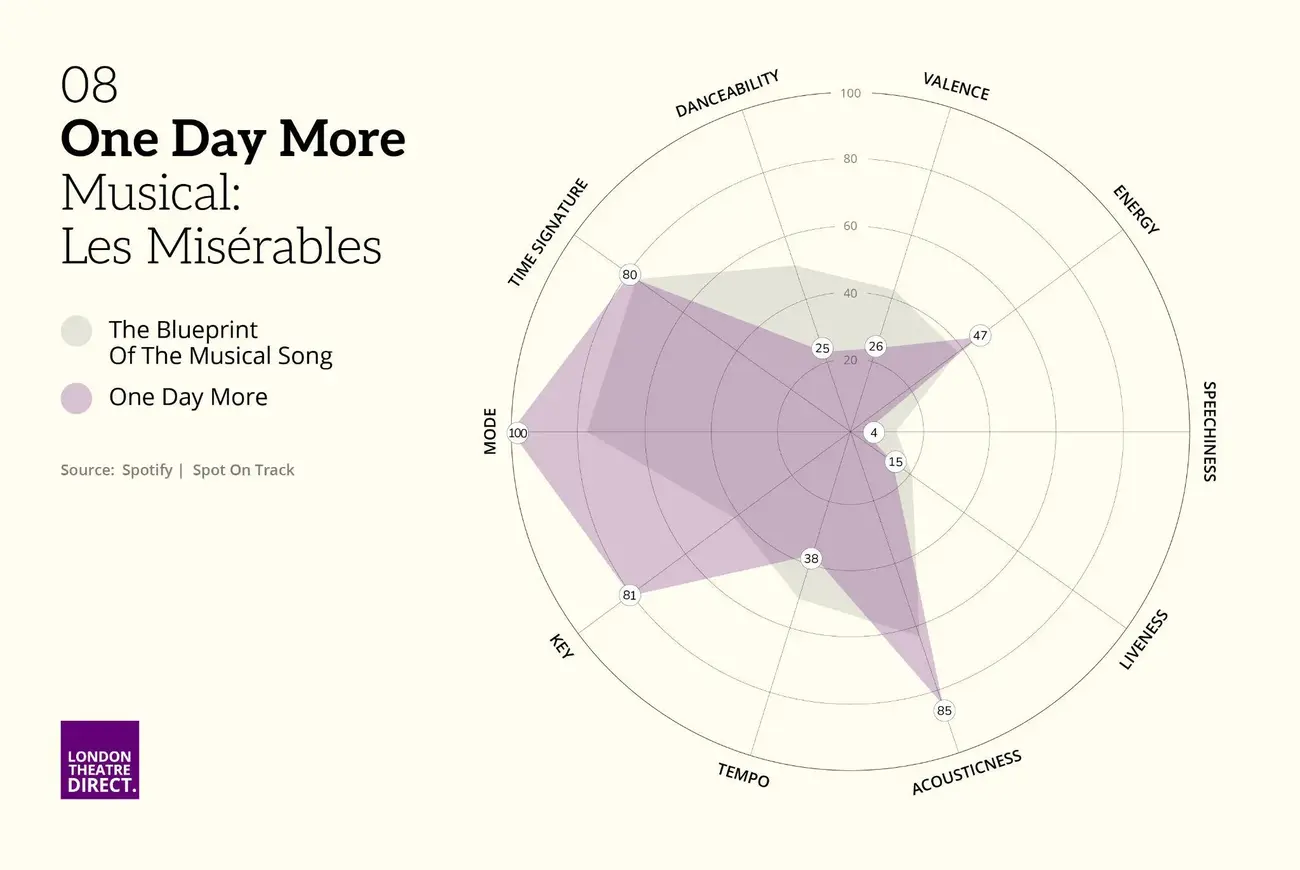
What makes it special:
This sweeping ensemble number is the
emotional climax of Les Misérables. Its low danceability (25)
and valence (26) reflect its solemn tone, while the moderate
energy (47) allows the vocal power of the cast to shine. The high
acousticness (85) reinforces its grandeur and timeless quality. This song
thrives on its narrative and emotional weight, solidifying its status as a theatre
classic.
9. ‘Welcome to the Rock’ - Come From Away

What makes it special:
This high-energy opening number from
Come From Away is driven by its danceability (70) and
valence (72), creating a sense of optimism and camaraderie. The
moderate speechiness (37) reflects its conversational storytelling
style, while the steady tempo (80 BPM) keeps it engaging. Its upbeat
tone and sense of community make it an audience favourite.
10. ‘Cabaret’ - Cabaret
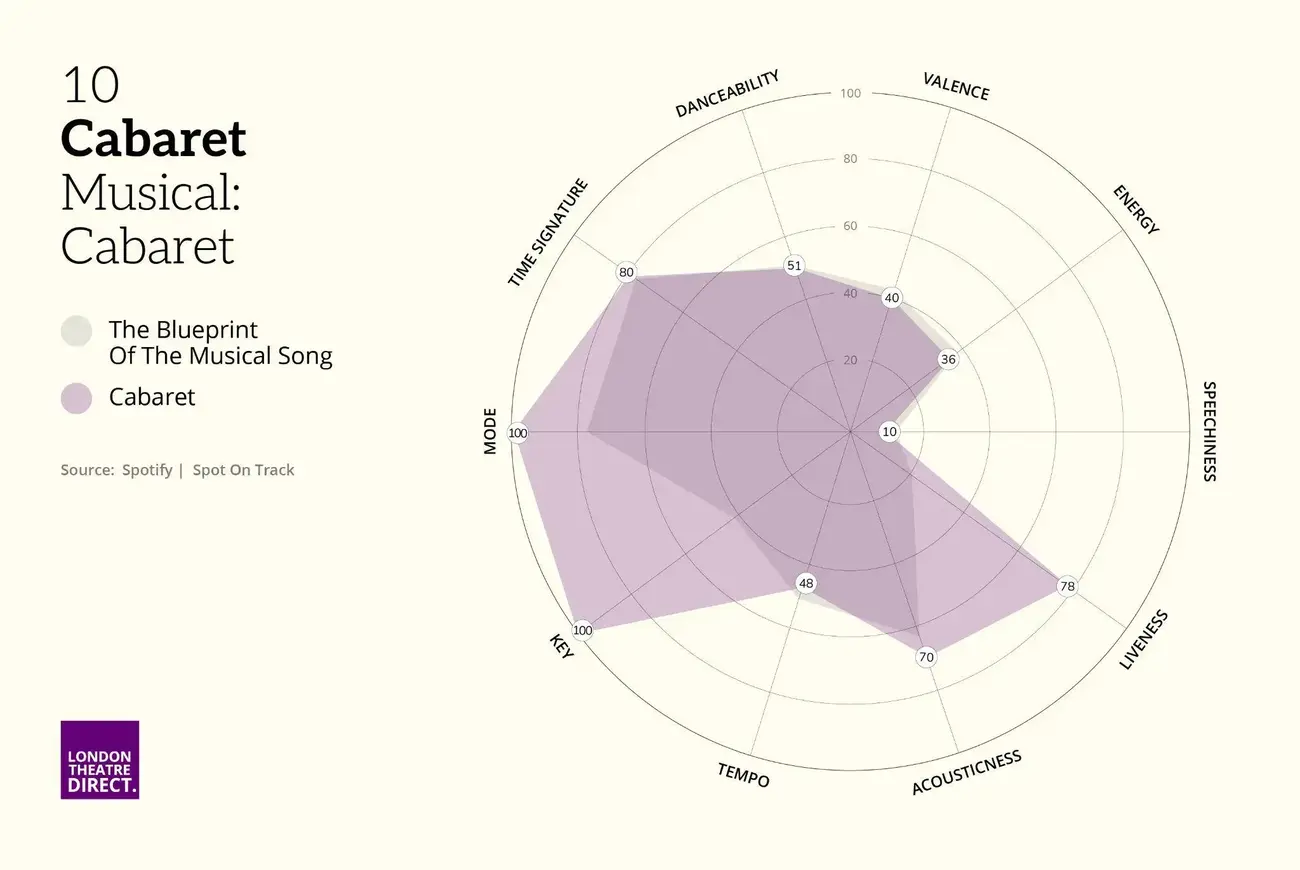
What makes it special:
With high liveness (78) and
acousticness (70), “Cabaret” captures the raw intimacy of a live
performance. Its moderate valence (40) and energy (36)
reflect the bittersweet tone of the musical, blending joy with an underlying darkness.
This balance of emotion and performance quality makes it a timeless hit.
11. ‘The Phantom of the Opera’ – The Phantom of the Opera

What makes it special:
A dramatic, high-energy (72) theatrical masterpiece with low
valence (30) and extremely low acousticness (10), creating
a dark, haunting atmosphere. The minor key (0) and commanding
orchestration make it one of the most intense and operatic pieces in musical theatre.
Unlike the archetypical song, which maintains moderate energy (39) and higher
acousticness (64), this track is fully amplified and symphonic, designed to
overwhelm the senses and heighten tension.
12. ‘I Don’t Know How to Love Him’ – Jesus Christ Superstar
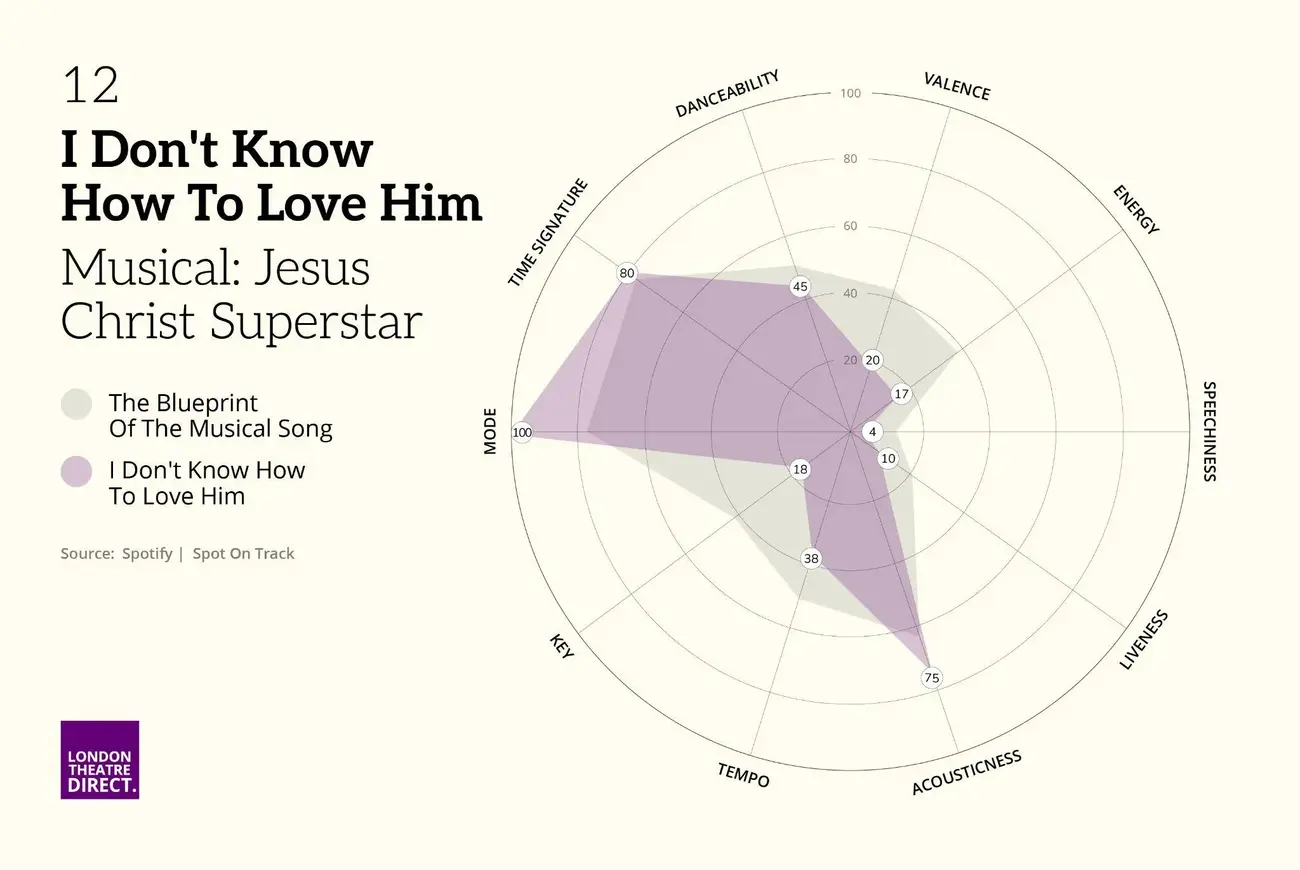
What makes it special:
A deeply introspective ballad, featuring low energy
(17) and a slow tempo (38 BPM), allowing the emotions to
take centre stage. The high acousticness (75) enhances its raw,
vulnerable quality, making it one of Andrew Lloyd Webber’s most heartfelt compositions.
While the archetypical musical song sits at moderate tempo (52 BPM) and energy
(39), this song slows everything down for an emotional, confessional
effect, making it a stark contrast to high-energy theatrical numbers.
13. ‘Agony’ – Into the Woods
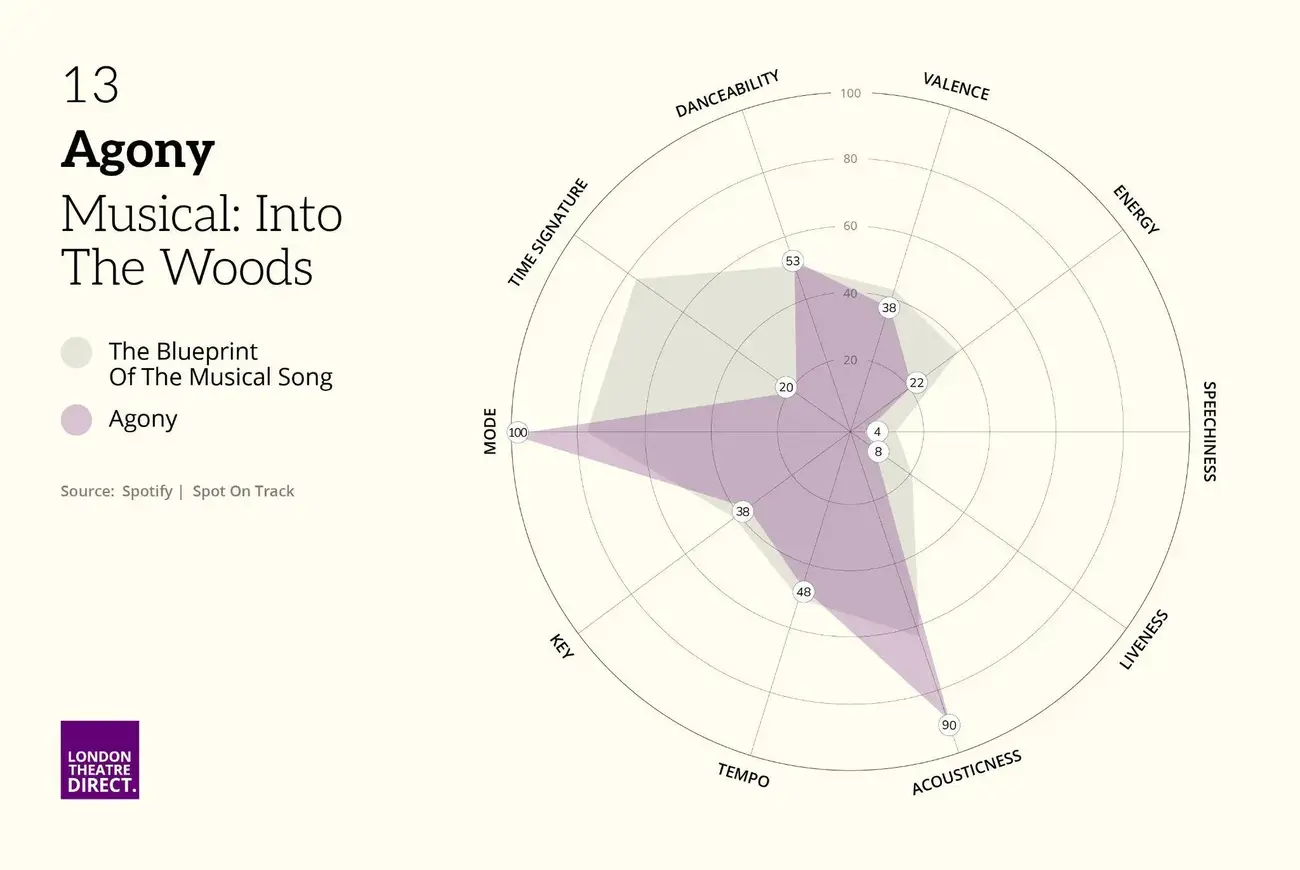
What makes it special:
A comedic duet with moderate danceability (53) and
low energy (22), focusing on rhythmic delivery and exaggerated
emotions. The high acousticness (90) keeps it firmly theatrical, while
the low valence (38) reflects its self-indulgent, melodramatic tone.
Compared to the archetype, which maintains a more balanced mix of elements,
Agony leans into lower energy and exaggerated expressiveness,
making it less about narrative propulsion and more about humour and character play.
14. ‘The Heat Is On’ – Miss Saigon
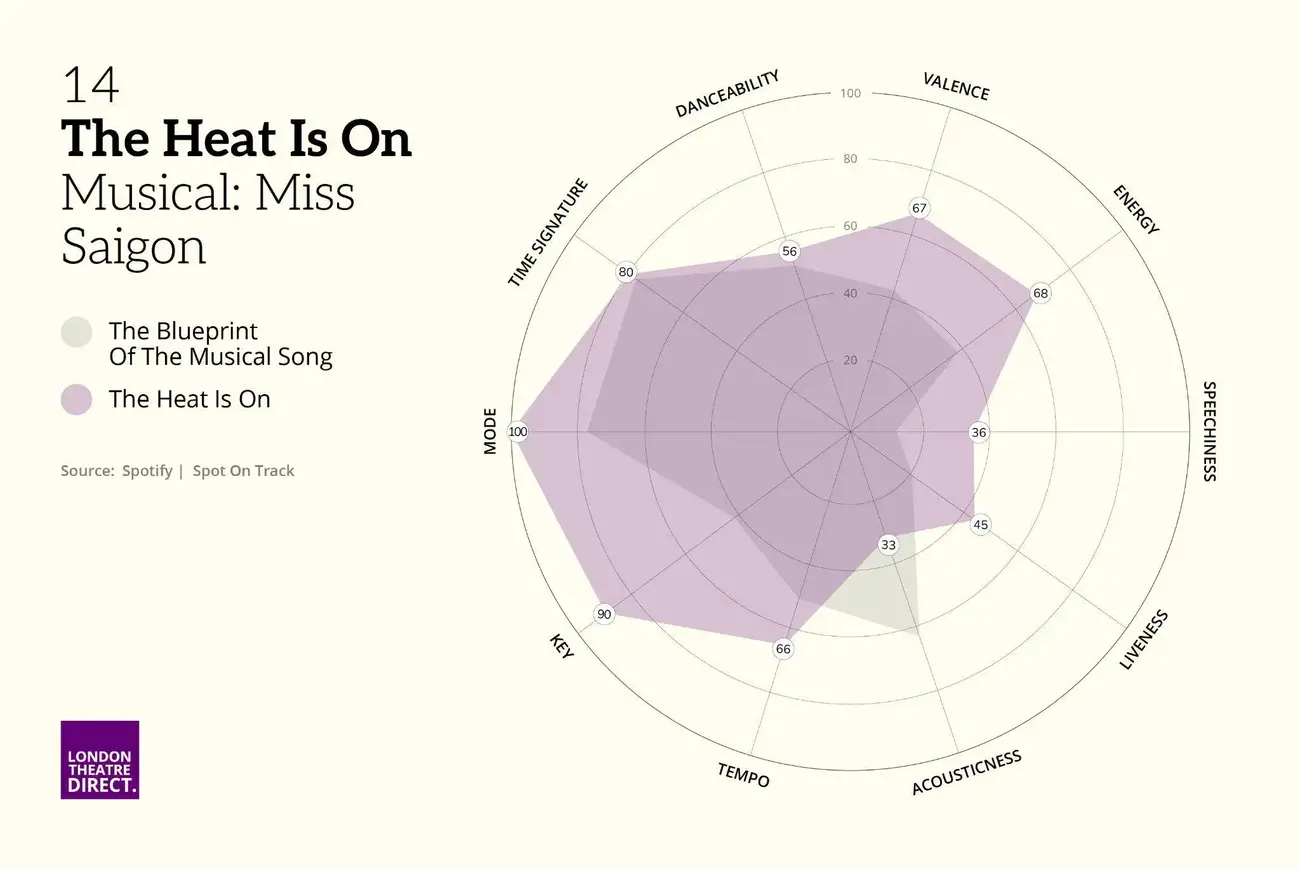
What makes it special:
A high-energy (68), high-danceability (56) spectacle with
elevated speechiness (36), reflecting its immersive nightclub setting.
The high liveness (45) makes it feel like an in-the-moment, pulsing
performance, contrasting with traditional ballads. While the archetypical song keeps
speechiness low (13) and liveness moderate (22) for a more structured,
composed feel, The Heat Is On mimics real-world intensity with dialogue-like
lyrics and an electrified pace.
15. ‘America’ – West Side Story

What makes it special:
A highly rhythmic (danceability 59, tempo 74 BPM) and vibrant track
that
balances a minor key (0) with a high valence (72),
creating an exciting push-and-pull of tension and celebration. The high
acousticness (81) maintains its rich orchestral and Latin-influenced sound.
Unlike the archetypical musical song, which has a lower tempo (52 BPM) and
valence (43), America pushes both rhythm and positivity to
higher levels, making it one of the most danceable and dynamic numbers in
musical theatre.
16. ‘Attend the Tale of Sweeney Todd’ – Sweeney Todd
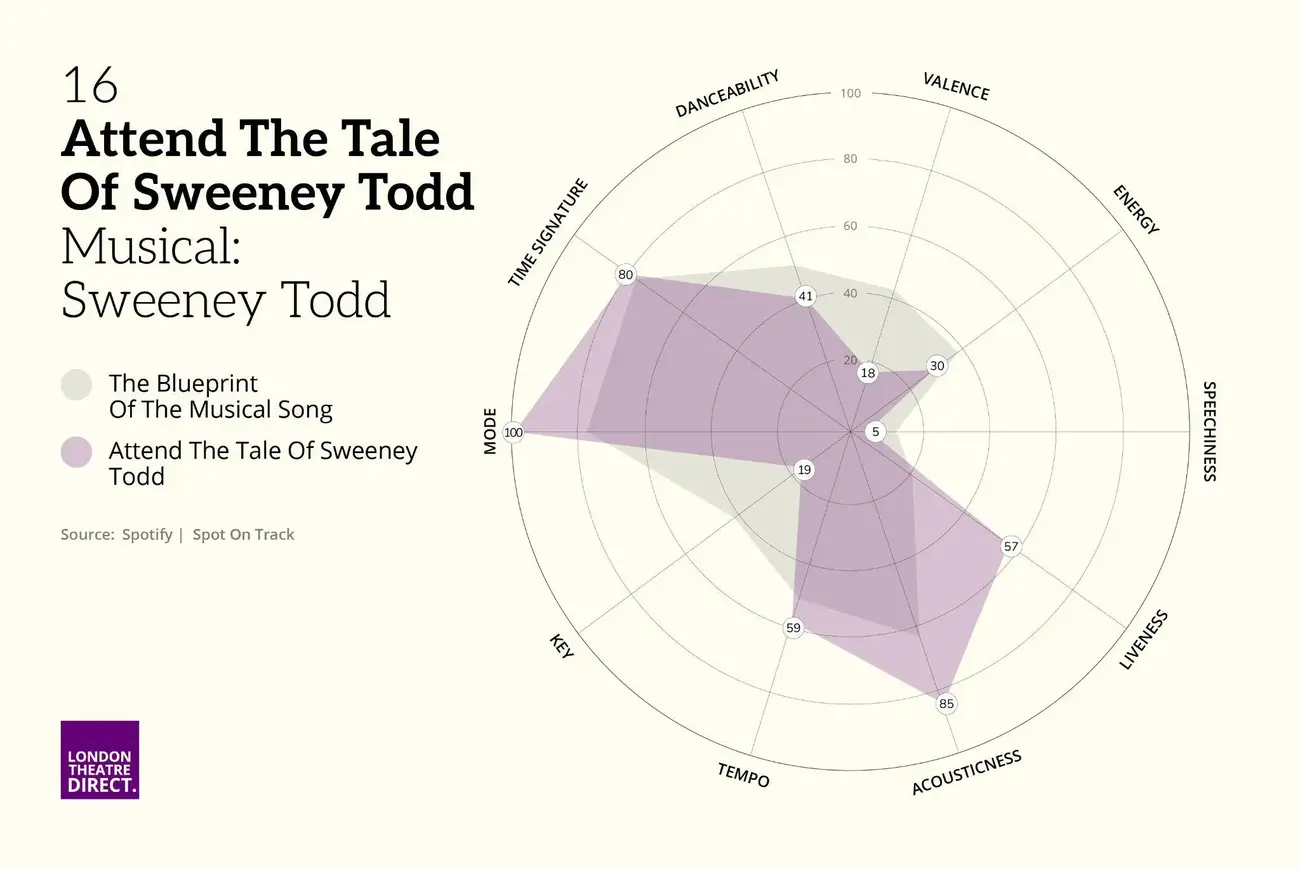
What makes it special:
A low-energy (30), eerie opening number that relies on low
valence (18), high liveness (57), and high acousticness (85) to create a
chilling, chant-like atmosphere. While the archetypical musical song maintains a
moderate valence (43) and energy (39), this track drops both
dramatically, making it unsettling and foreboding rather than balanced and engaging. Its
higher liveness (57 vs. 22) gives it a raw, almost ritualistic feel,
reinforcing its role as a sinister prologue rather than a conventional show tune.
17. ‘Tell Me It’s Not True’ – Blood Brothers
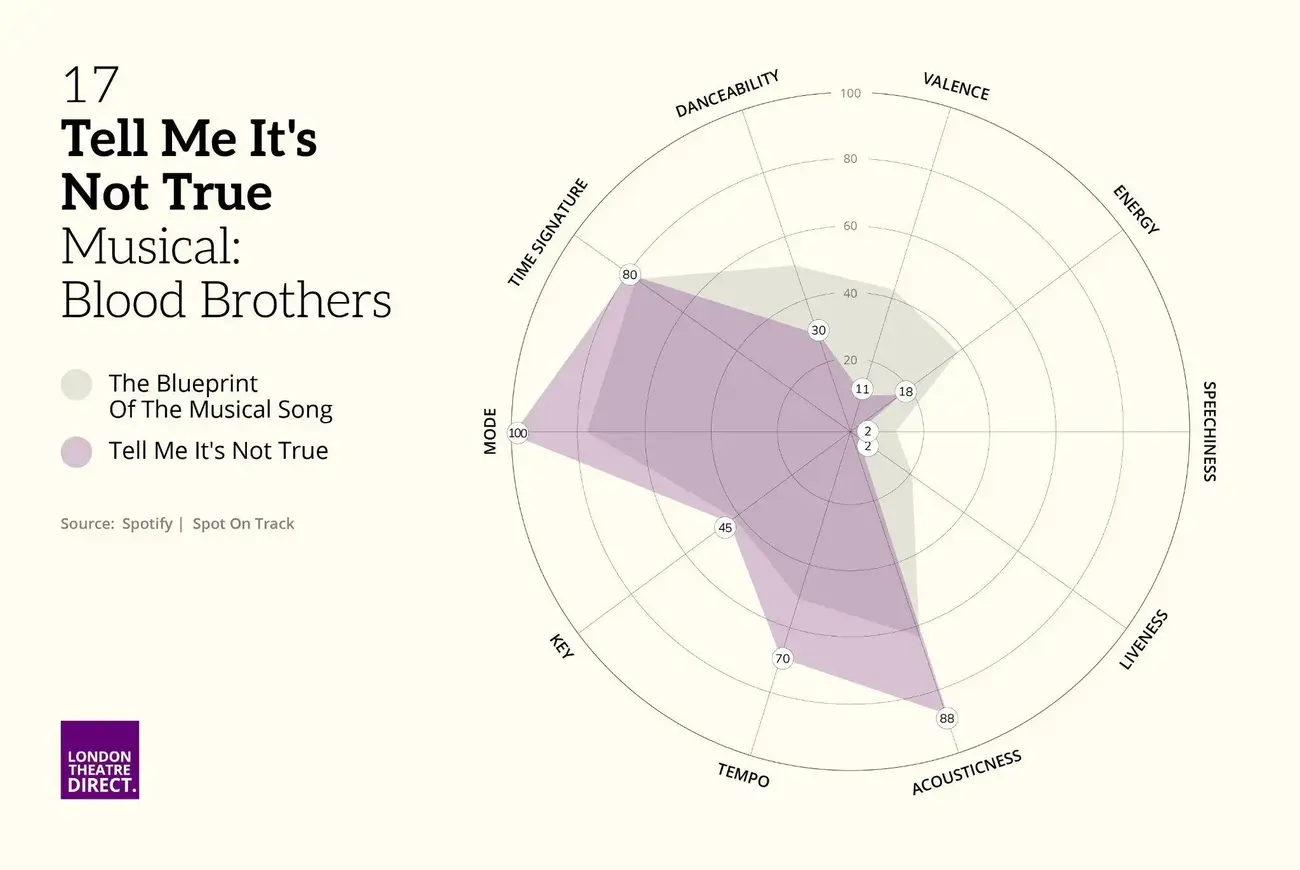
What makes it special:
The lowest valence (11) of all top-streamed songs, making it a
heartbreaking and sorrowful ballad. Its low danceability (30) and low energy
(18) ensure that the emotional weight is fully absorbed by the audience.
Compared to the archetypical song, which has higher valence (43) and
danceability (51), this track moves deliberately in the opposite direction,
stripping away rhythmic engagement to fully immerse the listener in its emotional
devastation. The high acousticness (88) enhances its intimacy, making
it feel more like a personal lament than a structured theatre number.
18. ‘Luck Be a Lady’ – Guys and Dolls
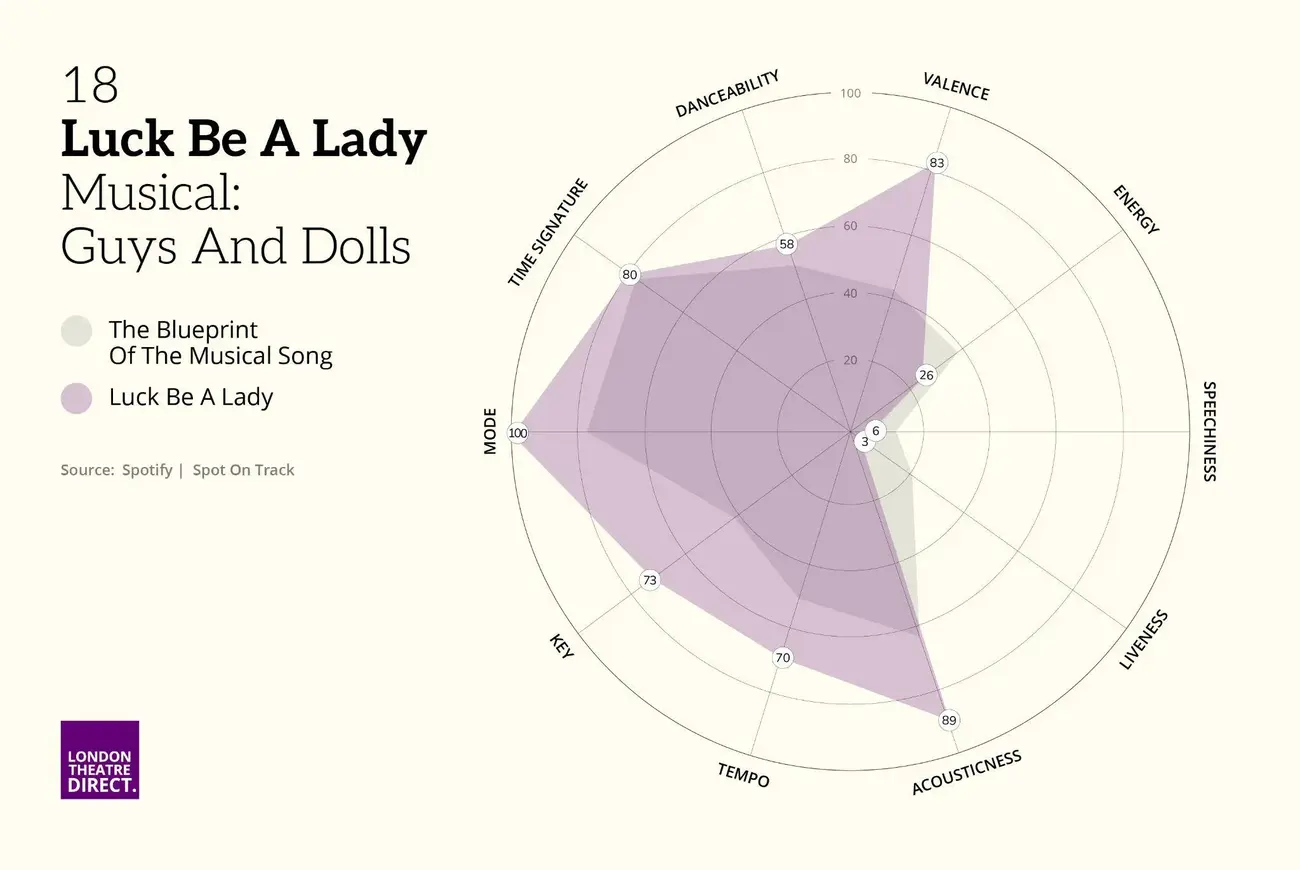
What makes it special:
A classic, jazzy show tune with high valence (83),
giving it an optimistic, upbeat quality. Despite its smooth and relaxed low
energy (26), it remains engaging due to its rhythmic swagger and
high acousticness (89), keeping it firmly in the realm of old-school
Broadway charm. While the archetypical musical song maintains moderate valence
(43) and a balance of energy (39), Luck Be a Lady swings toward a
more stylistic, personality-driven number, prioritising charm and charisma over
emotional weight or dramatic storytelling.
19. ‘The Ladies Who Lunch’ – Company

What makes it special:
A low-energy (24), speech-driven performance that combines
moderate danceability (60) with high acousticness (68)
to create a dry, sharp, and intimate feel. Unlike the archetypical musical song, which
has a more balanced mix of energy (39) and structure (speechiness 13),
this song leans heavily into a conversational, almost spoken-word style. Its low
valence (40) and sarcastic delivery set it apart, making it a biting social
critique rather than a traditional Broadway melody.
20. ‘Pumping Iron’ – Starlight Express
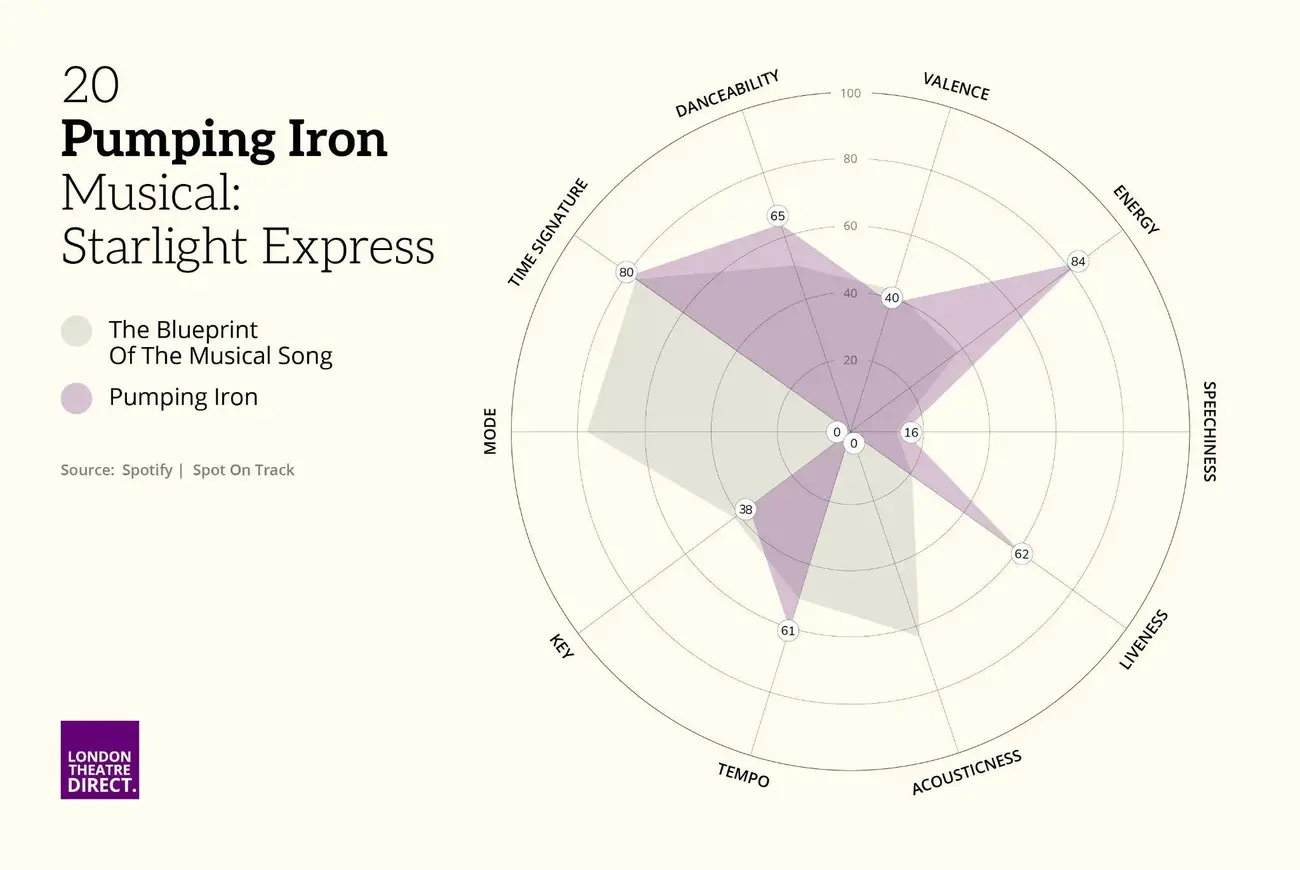
What makes it special:
The highest-energy song (84) in the group, with high
danceability (65) and high liveness (62), making it a rock-infused,
rhythm-driven powerhouse. Unlike the archetypical song, which tends to be more
reserved in energy (39) and tempo (52 BPM), Pumping Iron goes
all-in on fast-paced, rock-inspired theatricality. The low acousticness
(0) removes any sense of traditional instrumentation, replacing it with a
fully electrified, high-impact production style that feels closer to a rock concert than
a classic musical number.
What Sets the Most-Streamed Musical Songs Apart?
While the most-streamed musical songs diverge from the archetypical balance in different ways, they share key commonalities that make them streaming sensations. These tracks have mastered the art of standing out while resonating deeply with audiences both in the theatre and beyond.
-
1. Memorable Emotional Impact
These songs excel at capturing heightened emotions, whether it’s empowerment (“Defying Gravity”), rebellion (“Don’t Lose Ur Head”), nostalgia (“My Favorite Things”), or collective camaraderie (“One Day More”). They connect with universal human experiences, allowing audiences to relive those moments long after the curtain falls. Emotion is a driving force that keeps listeners pressing play again and again.
-
2. Narrative Power
Each of these songs is a pivotal moment in its respective musical, serving as a key turning point or encapsulating the essence of the show’s story. Tracks like “Alexander Hamilton”, “Waving Through a Window”, and “Welcome to the Rock” are rich in narrative detail, using their lyrics and music to pull listeners straight into the world of the musical. This storytelling quality makes them deeply engaging, even outside the theatre.
-
3. Genre-Blending Appeal
These tracks often step outside traditional musical theatre styles, incorporating elements of contemporary genres like hip-hop (“Alexander Hamilton”), pop (“Don’t Lose Ur Head”), or rock (“Time Warp”). This modernisation makes them more accessible to casual listeners and younger audiences who may not typically engage with musicals.
-
4. Singability and Catchy Hooks
From “Seasons of Love”’s heartfelt chorus to the infectious rhythm of “Time Warp”, these songs all have hooks or refrains that are easy to sing along to. Singability ensures their replay value and makes them staples in playlists, karaoke nights, and even viral social media moments.
-
5. High Energy and Theatricality
Tracks like “Welcome to the Rock” and “Don’t Lose Ur Head” are driven by high energy, making them thrilling to listen to. Even slower-paced tracks like “One Day More” pack emotional intensity into ensemble vocals or dramatic builds, ensuring they leave a lasting impression. The larger-than-life theatricality of these numbers makes them feel epic, even when experienced through headphones.
The most-streamed musical songs rise above the archetype because they aren’t trying to be balanced—they embrace their extremes. They amplify specific elements, whether it’s intense emotion, energetic rhythms, or unique narrative styles, to create unforgettable moments. These tracks don’t just fit into the structure of a musical; they define it.
The Creatives That Got It Right
As part of our ongoing celebration of musical culture, this data-driven exploration not only highlights unforgettable tracks but also promotes a deeper understanding of why certain songs resonate so profoundly with audiences worldwide.
Specific songs aside, some musicals steal the limelight. Hamilton reinvigorated interest in American history and paid thanks to an almost unforgotten hero of the American revolution and one of the founding fathers of the United States. And while it lionised his achievements it also wasn’t, and isn’t shy to point out that the man that it celebrates, wasn’t without his flaws, which helped, and helps the audience to connect with the very human story at its core.
“Musicals like Hamilton and Wicked redefine the genre by blending traditional storytelling with modern musical influences,” says Ryan Woods. “This fusion is what keeps them relevant and continually resonant with new audiences.”
Likewise, both ‘Wicked’ and ‘Dear Evan Hansen’, are perpetual underdog stories that propel their seemingly unlikeable central characters into the hearts of the audience, but making them incredibly relatable, and that coupled with the incredible songs that make up their stories, are why they sit at the top of the musical streaming mountain.
The list of most streamed songs also includes hits from numerous globally famous musicals such as ‘Jesus Christ Superstar’, ‘The Phantom of the Opera’, ‘Starlight Express’, ‘Guys and Dolls’, ‘West Side Story’ and ‘Into the Woods’ among others, all of which have ensured that the Top 20 Most Streamed Musical Songs is a stagebound powerhouse that will live long in the hearts of the theatrical faithful.
A Peak Behind The Curtain - Meet The Musical Maestros
Based solely on the songs and productions listed in the most streamed top twenty, two composers stand out as the most successful, according to the volume of musical masterpieces they’ve created - Stephen Sondheim and Lord Andrew Lloyd Webber.
“Sondheim and Lloyd Webber shaped modern musical theatre in ways that will be studied for decades,” notes Woods. “Their ability to craft songs that serve both the narrative and emotional arc of a show is unmatched.”
So, next time you’re sitting in the stalls or the gods, waiting for one of their many productions to start, here are some little-known facts about both men that you can share with your best theatre buddy:
Stephen Sondheim
The Master and The Apprentice
At the age of ten, Sondheim became friends with the son of Oscar Hammerstein II, leading to a life-changing mentorship. Hammerstein criticised Sondheim’s early works with rigor, helping to shape him into one of the greatest lyricists and composers of all time, and Sondheim has often said that Hammerstein was like a surrogate father to him.
One Last Hurrah
Sondheim’s final musical, ‘Here We Are’ is due to make its West End debut in April 2025, three and half years after the tragic death of its composer.
A Home Away From HomeFollowing its multi-million pound refurbishment in 2019, the Queen’s Theatre was renamed the Sondheim Theatreto honour Sondheim’s numerous contributions to musical theatre.
Cameoing on ‘The Simpsons’
Sondheim lent his voice to an episode of The Simpsons, where he humorously referenced his reputation for perfectionism, and this appearance and his ability to mock himself, delighted fans of both the show and Sondheim’s work.
Happy Birthday To You
Despite their vastly different styles, Sondheim and Andrew Lloyd Webber shared the same birthday, March 22nd.
Andrew Lloyd Webber
All Aboard
Thanks to the high-speed skating that’s central to the story of Andrew Lloyd Webber’s Starlight Express, it’s one of the most physically demanding shows to have ever graced the stages of the West End, and on average, three cast members have been injured during each of its numerous theatrical runs.
The Phantom Comes In Third
Andrew Lloyd Webber’s musical tale of unrequited love, The Phantom of the Opera, is the third longest running production in the West End behind The Mousetrap and Les Miserables and since it first stunned fans and critics alike in 1986, has been on stage for 39 years.
A Meeting Of The Minds
The most significant professional partnership in Lord Andrew Lloyd Webber’s life began on the 21st of April, 1965 when Tim Rice wrote to him, after being given his address by the literary agent Desmond Elliot. It was a partnership that helped to define both men, personally and professionally.
Putting His Money Where His Mouth Is
Lloyd Webber’s love for theatre extends beyond writing music and he owned and was ultimately responsible for operating six West End theatres, including the Palladium and the Theatre Royal Drury Lane, which has helped to ensure, and save, their musical legacy for future generations.
Don’t Cry For Me Argentina Andrew Lloyd Webber’s musical ‘Evita’, based on the life story of Eva Perón, debuted in the West End on the 21st of June 1978, which makes the show older than the woman whose life it celebrates, as Eva died, having risen to become one of the most powerful, and the most famous woman in the history of Argentina, when she was just 33 years old.
Encore, Encore…
Before the final curtain falls on our time together, we thought that it would be fun to deliver an encore performance filled with fun facts about some of the most popular musicals that have both appeared on the West End stage and are also featured in the Top 100 musicals that were examined to compile this list.
The Phantom of the Opera

- The Lake Beneath The Opera House: The underground lake beneath the theatre in the show is based on reality, as there’s an artificial lake beneath the Palais Garnier in Paris. Even though it’s now been sealed off and can’t be accessed, the lake still exists. And the boat used by the Phantom in the show? It’s made more than 25,000 journeys to his lair.
- How Many Phantoms? During its Broadway run, fifteen different actors played the Phantom, and even though he may not be a household name Howard McGillin, one of the aforementioned fifteen, does hold a musical record, as he played the titular role more than 2,500 times.
- And His Name Is… Even though the Phantom is never referred to by his name during the musical, in the original novel by Gaston Leroux that the production is based on, the “hero” of the story is named Erik.
- A West End Blockbuster: When the original production of ‘The Phantom of the Opera’, with Michael Crawford in the leading role, debuted in the West End, fans slept outside the theatre and queued down the street to get tickets. It was the very definition of a theatrical “blockbuster”.
- The Phantom Will See You Now: One of the strangest stories about the show was that its original star, Michael Crawford wasn’t the first choice to play the Phantom, the former lead singer of Cockney Rebel and musician Steve Harley was. But the show’s producers didn’t think that he had the acting experience and wasn’t a well-known enough “name” to carry the show, and so went with Crawford instead.
Hamilton
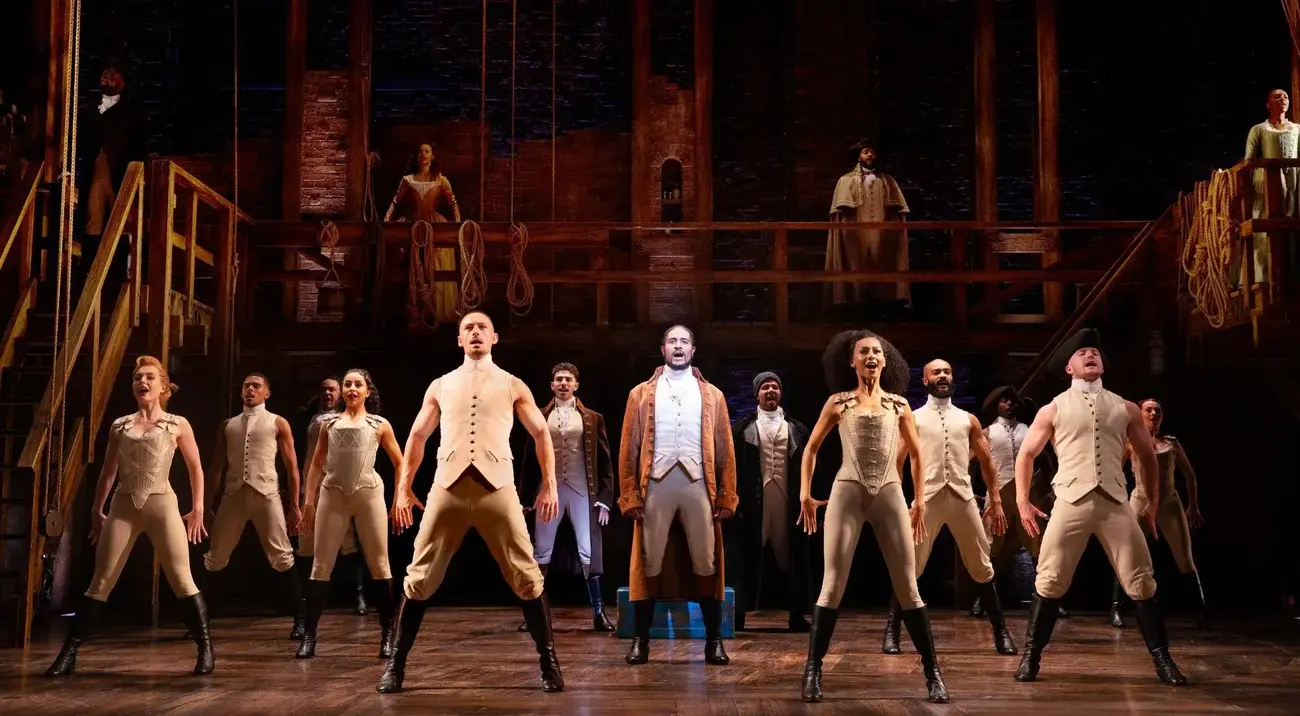
- Inspired by Literature: Lin-Manuel Miranda was inspired to create Hamilton after reading Ron Chernow’s biography of Alexander Hamilton during a vacation.
- Diverse Casting: The musical features a mainly minority cast, showcasing immigrants and outsiders as a moving force in American history and providing representation to people who have never seen someone who looked like them on stage in both Broadway and West End productions.
- Rap and Hip-Hop Influence: Hamilton incorporates rap and hip-hop music to tell the story, which was, and still is a groundbreaking choice for a musical.
- It Took A While: Despite, or possibly because of, having already found massive success with In the Heights, it still took Lin-Manuel Miranda two years to write the show’s first two songs.
- Record-Breaking Tony Nominations: At the 70th Tony Awards, Hamilton received a record-breaking 16 nominations and won 11 awards, including Best Musical.
Wicked
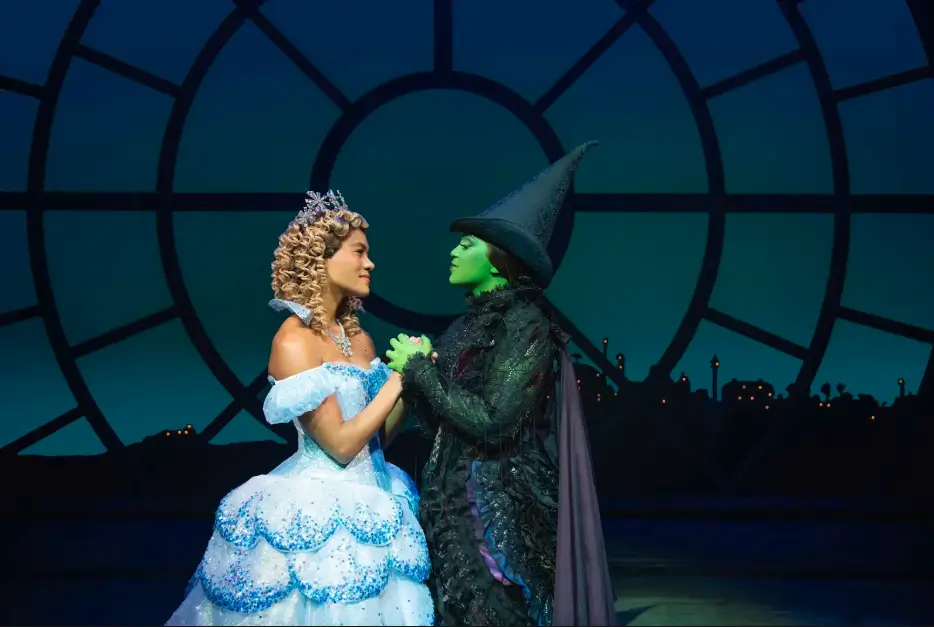
- What’s In A Name?: The name “Elphaba” is derived from the initials of L. Frank Baum, author of the production’s “sequel” The Wonderful Wizard of Oz.
- Age Before Beauty: The journey from Gregory Maguire's novel to the stage took several years and was littered with multiple script revisions and workshops.
- Approved By Tony: Despite its massive success, Wicked lost the 2004 Tony Award for Best Musical to Avenue Q, which remains one of the most surprising upsets in Broadway history. It was, however, nominated for ten awards, taking home three: Best Actress in a Musical, Best Scenic Design and Best Costume Design.
- The Wonderful Hidden Oz: The musical includes subtle nods to the original Wizard of Oz, such as Glinda’s bubble, the yellow brick road, and a reimagined take on the Wicked Witch’s iconic green skin.
- A Centrepiece Of Pop Culture: The musical has been referenced in various TV shows and movies, including the 2024 box office hit, and has inspired a dedicated fan base, solidifying its place as one of Broadway and the West End’s most beloved productions.
Methodology: Cracking the Code of the Perfect Musical Song
Our approach combined Spotify audio attributes and data-driven analysis to identify what makes a great musical hit. By gathering raw data from a master playlist of the top 100 musicals and using a statistical approach, we analysed what audio features make an archetypical musical hit, and combined those with streaming data to identify the top hits.
Data Collection
We used Spotify’s API to gather data on various musical attributes for a selection of songs. These attributes include:
- Danceability: How suitable a track is for dancing
- Valence: The positivity conveyed by a track.
- Energy: A measure of intensity and activity in the music.
- Speechiness: Detects the presence of spoken words in a track.
- Liveness: Detects the presence of an audience in the recording.
- Acousticness: A measure of how acoustic or non-electronic a track is.
- Tempo: The speed or pace of a track, measured in beats per minute (BPM).
- Key: The musical key in which the song is composed, represented numerically.
- Mode: Indicates whether a song is in a major or minor key, adding to its emotional tone.
- Time Signature: The musical meter that defines how beats are grouped in each measure.
Note: This methodology utilises 10 out of the 13 features available from Spotify’s web API. The selection of these 10 attributes is primarily informed by the considerations outlined in “What Makes a Song Likeable?”, which analyses only six attributes. However, an additional four features—Tempo, Key, Mode, and Time Signature—have been included to enhance precision and provide a more comprehensive analysis deemed suitable for musical theatre.
Playlist Selection
For our playlist selection, we gathered the Spotify albums for the top 100 musicals and added these to a master playlist.
Where there was an option to choose original cast/ musical albums this was done. In the cases where this was not possible either the new theatre productions/ recasts or motion picture albums were chosen.
Song Analysis
For each song in the selected playlist, we collected audio features such as danceability, valence, energy, and more using the Spotify API. Additionally, we extracted information about the song’s title, artists, and other relevant details
To ensure that songs from different playlists/albums were comparable, we normalised the values of selected attributes to a common scale of 0 to 100, helping with a fair comparison between songs and features.
Radar Charts
We created radar charts for each song, displaying their danceability, valence, energy, speechiness, liveness, acousticness, tempo, key, mode, and time signature. These radar charts provide a visual representation of each song’s characteristics.
The Archetype of the Musical Song
To identify the archetype for the musical song, we calculated the average values of the selected attributes across all songs in the analysed playlists and this average represents the median musical profile for a musical banger.
Similarity Ranking
We ranked the songs in the playlists based on their similarity to the typical musical song. Cosine similarity was used as a measure of similarity, ranging from -1 (completely dissimilar) to 1 (completely similar). This ranking allowed them to discover songs that closely match the desired musical parameters.
Visualisation
To visualise the results, we overlaid the radar chart of the musical song archetype with those of the top 25 songs that were most similar to the archetype.
Spotify Streaming Numbers
We took top twenty musicals from the Top 100, and using SpotOnTrack went through the original cast recordings to ascertain what the top streamed songs from each were, and then used the provided numbers to rank them accordingly.
Conclusion
By following this methodology, we were able to identify the best musical songs available on Spotify.
Sources
- API Detail - Spotify API
- Top 20 Most Streamed Songs - SpotOnTrack
- Musical Facts -Mental Floss , Andrew Lloyd Webber, Golden Tours, What’s On Stage, CBC, Buzzfeed, Stage Door and Guide London
- Likeability - Toward Data Science
- Top 100 Musicals - What's On Stage
